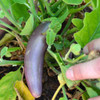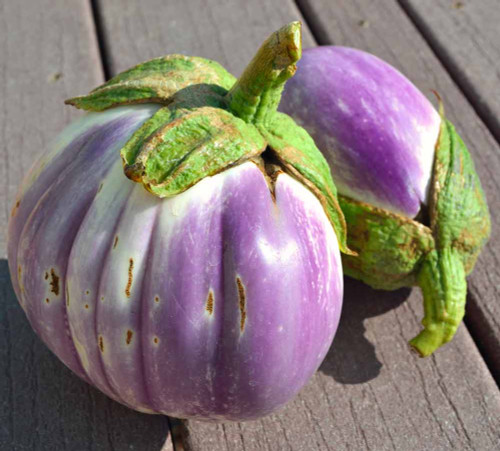Long Purple Italian Eggplant Seeds - (Solanum melongena var. esculentum)
- SKU:
- V1269
- Seed Count:
- Approx 50 seeds per pack
- Days to Maturity:
- 70-80 days
- Days to Germination:
- 14-21 days @ 70-75F
- Plant Spacing:
- 2-3'
- Light Preference:
- Full sun
- Soil Requirements:
- Well drained
- Status:
- Heirloom, Non-Hybrid, Non-GMO seeds
Description
Long Purple Italian Eggplant - Perfectly Beautiful and Delicious
This Italian heirloom eggplant is long and slender with fewer seeds and thin skin, making it ideal for cooking. The flavor is both richer and milder than most, illustrating why this traditional Southern Italian ingredient is essential to so many time-honored dishes. Some of the best eggplant recipes are southern Italian pasta dishes.
Looking much like a purple zucchini, this remarkably productive long dark purple eggplant is usually 8-10” long and 2 1/2” in diameter with very tender and flavorful yet firm mild flesh, typically yielding four or more fruit per plant.
Long Purple is an old Italian heirloom probably brought to the US in the late 1880s to early 1900s. The Italian name melanzana came from the initial suspicions of the fruit being a nightshade and therefore dangerous, so they gave the eggplant its name mela insane, translating to the apple of insanity and when shortened became melanzana.
Details
While it may look similar to the usual globe-shaped eggplant in the grocery store, this Italian eggplant is distinct and unique. Fruits are slightly smaller and longer and the flesh is tender and less bitter.
Grows best in consistently warm, moist climates, where they grow year-round as short-lived perennials. If you grow with a shorter warm season, start plants indoors and transplant out after frost danger has passed and the soil is warm to the touch in the morning.
Use row covers for late-season cool snaps. Plants grow and produce best when temperatures are between 65 and 90°F.
Eggplant does not store well, becoming bitter quickly, so plan to use it just after harvesting. The best-tasting eggplant dishes start with freshly harvested fruit, with people commenting how sweet they are fresh, compared to the week-old eggplant in the grocery store.
If needed, it can be stored overnight at room temperature.
History
As a Solanaceae or nightshade family member, eggplant’s cousins are tomatoes, peppers, and potatoes.
It is thought to have originated in a region covering northeast India and Burma, to Northern Thailand, Laos, Viet Nam, and Southwest China where it still grows wild – a spiny, bitter, orange, pea-sized fruit that has been cultivated and refined for over 1,500 years.
Several Sanskrit documents dating from around 300 BCE mention eggplant with various descriptions, suggesting its popularity as both food and medicine.
China embraced it as an important vegetable crop, repeatedly confirmed by its presence in important works such as the Atlas of Plants in Southern China written during the Western Jin Dynasty (265-316 CE), and the Qimi Yiaoshu, a practical handbook of agriculture during the Southern and Northern Dynasties (420-581 CE). Japan received it, probably through trade, in the 8th century around the time of the Tang dynasty. Li Shihzhen, in his 16th-century Compendium of Materia Medica on over 1,800 traditional Chinese medicinal herbs, mentions eggplants with various colors – white, yellow, azure, and purple - that we know today.
The ancient Greeks and Romans did not seem to know about eggplant, yet it traveled throughout the Mediterranean Basin with the Muslim expansion in the 7th and 8th centuries. Persian and Arab sailors brought seeds to Eastern Africa in the 8th century, leading to the numerous terms for eggplant in Ethiopia.
Eggplant was a common and prized vegetable in 12th-century Southern Spain controlled by the Moors, documented by the Andalusian-Arab physician Abul al Walid Ibn Rushd descriptions, and by Ibn Al Awam’s description of cultivation details in his Book of Agriculture. He describes four types under cultivation – Egyptian with white fruit and violet flower petals, Syrian having violet fruit and light blue flower petals, local being dark purple and purple flower petals), and Cordoban having black fruit.
Similar types were cultivated in Israel during the Mamelouk period of 1250-1517.
Eggplant was quite commonly mentioned, illustrated, or both in late Medieval and Renaissance books, illustrations, and documents. German philosopher, theologian, and scientist Albertus Magnus discussed eggplant in his De Vegetabilibus, published in 1256. The first European illustration currently known is in the Italian treatise De Herbis, an illustrated herbal which comes from a collection of pharmacological texts written in the early 1300s in southern Italy.
Medieval and early Renaissance Europe was conflicted towards eggplant, recognizing its nightshade relations, so included warnings, as well as medicinal, and culinary information. As early as the 12th century, it was noted that the bitterness and pungency of eggplant could be reduced by using salt and rinsing before cooking.
Eggplant is thought to have been initially brought to the Americas during the Spanish Age of Exploration in the 15th through 17th centuries, reported in Brazil in the mid-17th century.
The late 18th century introduced the first seed catalogs featuring hand-drawn or sometimes painted images, with the Vilmorin edition of 1760 noting eggplant as an ornamental annual.
Thomas Jefferson grew and experimented with eggplant, as his 1812 journal lists both purple and white varieties.
Middle Eastern and Italian immigrants brought their seeds and recipes to America late in the 19th century beginning its rise as a popular vegetable.
Uses
Most garden vegetables are best used fresh, just after harvesting; eggplant is especially so as it starts turning bitter within about 24 hours after harvest. Choose your recipe before harvesting, then straight to the kitchen for a delicious meal!
Young eggplant should be harvested when they are about one-third full size. If your thumbnail leaves a slight indentation after lightly pressing the skin of the fruit, it is ripe and ready to be picked. Cut the fruit off the plant rather than breaking off the fruit to prevent damage and disease from entering the plant.
Italian eggplant is best suited for cooked applications such as frying, baking, sautéing, grilling, and pickling. They benefit from the porous flesh, absorbing accompanying flavors with ease. They make an excellent fresh appetizer when grilled and served with mozzarella, basil, tomatoes, and a sprinkle of olive oil.
Southern Italians love their eggplant, in fact, when a pasta dish is described as Sicilian-style, it often contains diced eggplant in addition to tomatoes and mozzarella.
One of the most famous dishes in Ottoman cuisine is Imam bayildi — which translates as “the imam fainted”. The dish consists of a whole young eggplant stuffed with onion, garlic, and tomatoes, then simmered in olive oil. The story goes that it was so delicious the imam who first ate it fainted out of pure delight. Or was it in shock because the olive oil used in the recipe was so expensive? Either way, it is one of the most memorable ways to cook eggplant.
Italian eggplant pairs well with tomatoes, bell peppers, zucchini, parmesan and mozzarella cheese, onions, garlic, herbs such as basil, arugula, and oregano, capers, green olives, pine nuts, olive oil, red wine vinegar, and grilled steak, veal, and lamb.
Avoid refrigeration as eggplant easily suffers chill damage, making it soggy.
Growing Tip
For most of North American gardeners, starting seeds indoors and transplanting them out after the soil warms up is the most successful method. In colder climates, sowing seeds indoors 6-8 weeks before your last expected frost date gives you larger, hardier plants that will produce fruit faster.
In longer-season climates, soaking the seeds overnight and planting them in warm soil greatly improves the germination rates. Ideally, the soil should be 80° to 85°F, but no less than 70°F for direct sowing. In warm soil, seedlings will appear in 7-12 days but can be delayed to three weeks or more in soil less than 70°F, risking rotting before sprouting.
Eggplant needs sun, so plant them where they have direct sun for most of the day. Hotter climates might need to provide afternoon shade to prevent sun scald of the leaves and developing fruit.
They have a shallow root system, so avoid cultivating too closely and clip – don’t pull – weeds carefully so as not to disturb their roots. A 2-3” layer of mulch suppresses weeds surprisingly well while keeping the roots cooler with more soil moisture available.
Eggplant is generally mildly drought tolerant but will produce more fruit with consistently moist soil. Drip irrigation on a timer avoids wetting the leaves, decreasing disease potential while keeping the soil moisture uniform.
Even though eggplant flowers are classified as “perfect”, meaning they contain both anthers (which produce pollen) and pistils (which receive the pollen), pollinator attractants nearby will increase successful pollination, giving more harvest, much like with tomatoes.
Companion Planting
Eggplant likes company, especially companion planting, getting along well with several vegetables, herbs, and flowers.
Grows well with – all beans, peppers, peas, and potatoes. Tarragon and thyme are also good.
Avoid – fennel, garlic, onion, and okra.
Learn More
- Growing Great Eggplant - What You Need to Know
- About Eggplant
- Sicilian Eggplant and Tomato Sauce
- How to Pick Perfectly Ripe Heirloom Vegetables
From the soil to the seed to the food you eat - we'll help you grow your best garden!
2 Reviews
-
Good producer
Started from seed with good germination and transplanted into the garden with good results. Started to produce in July and continued through mid-September. Fruit production was excellent with good shape and color. Did well in this area.
-
Very productive
These produced lots of long, delicious eggplant per plant.















